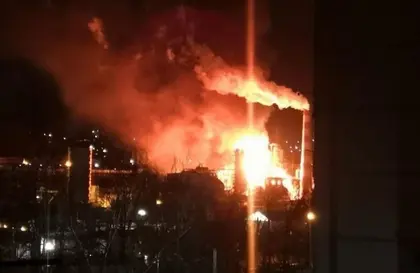Explosions rocked Russia’s biggest oil refinery on the Black Sea late Wednesday evening, in a Ukrainian drone strike run by the country’s national spy agency the SBU.
Multiple still images and video showed the fire was on the premises of a Tuapse oil refinery operated by the Russian oil company Rosneft.’ The major fuel and lubricants processing facility is Russia’s main oil terminal on the Black Sea, in pre-war years producing two million tons of product a year, almost all of it for export.
JOIN US ON TELEGRAM
Follow our coverage of the war on the @Kyivpost_official.
A center of mass geo-location of the 3000 m x 750 m heavy industrial site is N44.10078, E39.09340.
The attack reported at approximately 11:40 p.m. local time (EET, 21:40 GMT), took place one day after Ukrainian drones torched an oil terminal in the west Russian city Klintsy, and 48 hours after Ukrainian drones set a massive fire in the Russian Baltic Sea Ust-Luga terminal, halting all operations at the facility. In total, in the past six days, Russian oil and gas processing infrastructure has been hit with major drone raids four times.
One drone bound towards Tuapse apparently traversed portions of Russia’s densely populated Sochi region beach resort region, cruising at 200-300 meters’ altitude and easily visible to residents below.
One video recorded residents’ profanity-filled reaction to the aircraft’s passage through Russian airspace and, apparently, the fact that it wasn’t immediately shot down. The low-quality video showed an aircraft driven by a tail propeller similar in silhouette to a Ukrainian Bobr strike drone.

For the Clueless – Why Ukraine Matters
“Whore! It’s flying! (Vulgar) Scum! (Vulgar) Shoot it down, please! Shoot it down!” complained one observer, watching the drone head towards the oil refinery.
Footage of a Ukrainian attack drone heading toward the Russian Rosneft refinery in Tuapse earlier tonight. pic.twitter.com/iIT5jqZq5r
— OSINTtechnical (@Osinttechnical) January 24, 2024
An SBU source confirmed to Kyiv Post the spy agency was responsible: “An oil refinery in Tuapse, Russia, has become another target of the SBU. Our sources confirm that it was SBU drones that attacked this important facility for the enemy. After two powerful explosions last night, a large-scale fire broke out there. The primary oil processing unit, namely the vacuum and atmospheric columns, was damaged.
The SBU is striking deep into Russia and continues to attack facilities that are not only important for the Russian economy but also provide fuel for enemy troops. There will be many surprises to come, the systematic work continues."
According to multiple official and local resident reports, at least one drone struck in the center of the base. The reported number of drones launched at the facility ranged from one to three, and according to some accounts as many as two drones were shot down.
According to the independent Russian news information platform Astra, the drone struck oil-processing equipment inside the base containing 100 tons of gasoline/petrol, and 200 tons of fuel oil. All 38 staff on site were evacuated safely, the report said. Local motorists posted images of a major fire.
Tuapse, Krasnodar Krai, the Russian Rosneft oil refinery is currently burning. pic.twitter.com/zXAs9awYQ0
— OSINTtechnical (@Osinttechnical) January 24, 2024
Sergei Boiko, head of the Tuapse regional government, on his personal Telegram channel, posted “I am on the site of the fire. The vacuum package that is located on the oil terminal property is on fire. No one was hurt. The fire has been contained. It is being extinguished. I ask all to trust only official sources of information and not to place video from the site of the incident, to avoid unhelpful results.”
According to energy industry reports, recent Rosneft major upgrades to the Tuapse refinery included the construction of an atmospheric-vacuum crude distillation unit (CDU) for primary refining and the construction of a vacuum gas oil hydrocracking unit. It was not clear from Boiko’s comments whether either of those critical units was hit.
[Hydrocracking should not be confused with fracking or hydraulic fracturing, which is a hydrocarbon extraction technique where high fluid pressure created with a mixture of water, sand, and various chemicals is used to break underground rock formations and displace the fragments to free natural gas and raw petroleum oil from porous rock structures. – ed.]
[In contrast, hydrocracking is a technique used in the refinement process using heat and pressure in a dedicated facility to break apart long-chain hydrocarbon polymers, such as those in crude petroleum oil, into lighter and more useable products like gasoline, kerosene, benzene, jet fuel, etc. – ed.]
The Russian Aerospace Force overnight Wednesday-Thursday continued its long-running campaign to bombard Ukrainian cities and towns as part of a Kremlin strategy to compel Ukraine’s public to cease resistance.
A wave of Iranian Shahed suicide drones operated by the Russian military struck the Ukrainian Black Sea port city of Odesa shortly after midnight. According to Ukrainian Air Force official counts, 11 drones were shot down and three got through air defenses. Of the drone aircraft penetrating Odesa airspace, one blasted the upper floors of an upscale apartment building, another blew up in a furniture-manufacturing site, and a third robot plane hit an apartment building but failed to detonate. Six civilians were injured, Ukrainian official statements said.
What Russians did to Odesa last night using Iranian drones.
— Jay in Kyiv (@JayinKyiv) January 25, 2024
Just randomly destroying and killing as much as possible.
Zero military objective. Just terrorism while Russian Foreign Minister is treated like a king in New York City. pic.twitter.com/MzMpuqE9vp
Notwithstanding Boiko’s official appeal for members of the public not to share information about the Tuapse strike, residents armed with smartphones were quick to share images of orange flames inside the oil base reaching dozens of meters into the night sky. The fire was put out shortly before 5 a.m., local news reports said.
Authorities mobilized 99 firefighters and 31 firetrucks to contain the blaze. No one was hurt in the strike and authorities were still evaluating the scale of damage, local television channel Kuban 24 reporter Vannik Abraamyan reported in a Thursday morning live Tuapse stand-up.
“It was exactly five minutes to one in the morning. I noticed, that is, something went ‘Blam!’. So, I, you know, called [emergency response number] 112. The girl, that is, she told me ‘we’ve already sent a column of those, you know, firefighting trucks’,” a man identified in the report as a homeowner living near the site of the explosion told the news channel.
“Well, how? Well, I was somewhat worried, probably. It’s not normal. It’s probably connected with our situation. Probably it’s normal,” a draft-age man said.
The Kuban 24 report didn’t identify the man by name. Neither the reporter nor the interviewee mentioned Russia’s war with Ukraine directly during the television report.
On Russia’s less-censored public chat groups, posters pulled no punches and warned Ukraine’s military was not an opponent to be despised, no matter what Kremlin-controlled media is reporting.
“The drone strike in Tuapse is another reminder that we are not fighting suckers.
“They (Ukraine) have all European and, in general, all Western markets open to them. For example, [being supplied with] high-quality Canadian diesel engines for UAVs is no problem.
“Why are we writing this? Well, because many people (in Russia) have relaxed, and elderly ‘experts’ are again appearing on TV, and telling us how stupid the enemies around us are, and how Western missiles never hit anything,” griped the popular pro-Kremlin mil-blogger Povernutie na Z Voine to his 770,000+ followers.
Russian social media image of Tuapse oil refinery base on fire following probable Ukrainian drone strike. Shared by user Alina at 11:19 p.m. Moscow Standard Time (20:19 GMT) Wednesday evening on the Non-typical Tuapse (Нетипичный Туапсе) Telegram channel.
Civilian residential apartment building in the Ukrainian city Odesa burns following a strike by a Russia-operated Iranian Shahed kamikaze drone. Kremlin officials have vowed to break Ukrainian morale with a long-term bombardment of Ukrainian homes and businesses. Jan. 25 image published by the Odesa city police.
You can also highlight the text and press Ctrl + Enter











